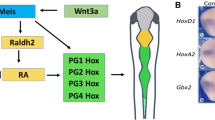Abstract
IT has been suggested that Hox genes play an important part in the patterning of limbs1–3, vertebrae4–6 and craniofacial structures5,7–9 by providing an ordered molecular system of positional values, termed the Hox code10,11. Little is known about the nature of the signals that govern the establishment and regulation of Hox genes, but retinoic acid can affect the expression of these genes in cell lines12–14 and in embryonic tissues2,11,15–17. On the basis of experimental and clinical evidence, the hindbrain and branchial region of the head are particularly sensitive to the effects of retinoic acid 15,18–21, but the phenotypes are complex and hard to interpret, and how and if they relate to Hox expression has not been clear. Here we follow the changes induced by retinoic acid to hindbrain segmentation and the branchial arches using transgenic mice which contain lacZ reporter genes that reveal the endogenous segment-restricted expression of the Hox-Bl (Hox-2.9), Hox-B2(Hox-2.8) and Krox-20 genes. Our results show that these genes rapidly respond to exposure to retinoic acid at preheadfold stages and undergo a progressive series of changes in segmental expression that are associated with specific phenotypes in hindbrain of first branchial arch. Together the molecular and anatomical alterations indicate that retinoic acid has induced changes in the hindbrain Hox code which result in the homeotic transformation of rhom-bomeres (r) 2/3 to an r4/5 identity. A main feature of this rhom-bomeric phenotype is that the trigeminal motor nerve is transformed to a facial identity. Furthermore, in support of this change in rhombomeric identity, neural crest cells derived from r2/3 also express posterior Hox markers suggesting that the retinoic acid-induced transformation extends to multiple components of the first branchial arch.
Similar content being viewed by others
References
Dolle, P. et al. Nature 342, 767–772 (1989).
Izpisua-Belmonte, J.-C. et al. Nature 350, 585–589 (1991).
Morgan, B. et al. Nature 358, 236–239 (1992).
Le-Mouellic, H., Lallemand, Y. & Brulet, P. Cell 69, 251–264 (1992).
Chisaka, O. & Capecchi, M. Nature 350, 473–479 (1991).
Kessel, M., Balling, R. & Gruss, P. Cell 61, 301–308 (1990).
Balling, R. et al. Cell 58, 337–347 (1989).
Chisaka, O., Musci, T. & Capecchi, M. Nature 355, 516–520 (1992).
Lufkin, T. et al. Cell 66, 1105–1119 (1991).
Hunt, P. et al. Nature 353, 861–864 (1991).
Kessel, M. & Gruss, P. Cell 67, 89–104 (1991).
Simeone, A. et al. Nature 346, 763–766 (1990).
Simeone, A. et al. Mech. Dev. 33, 215–227 (1991).
Papalopulu, N., Lovell-Badge, R. & Krumlauf, R. Nucleic Acids Res. 19, 5497–5506 (1991).
Papalopulu, N. et al. Development 113, 1145–1159 (1991).
Morriss-Kay, G. et al. EMBO J. 10, 2985–2996 (1991).
Conlon, R. & Rossant, J. Development 116, 357–368 (1992).
Durston, A. et al. Nature 340, 140–144 (1989).
Holder, N. & Hill, J. Development 113, 1159–1170 (1991).
Lammer, E. et al. New Engl. J. Med. 313, 837–841 (1985).
Maden, M. & Holder, M. Bioessays 14, 431–438 (1992).
Guthrie, S. et al. Nature 356, 157–159 (1992).
Sham, M.-H. et al. Cell (in the press).
Frohman, M., Boyle, M. & Martin, G. Development 110, 589–507 (1990).
Wilkinson, D. et al. Nature 341, 405–409 (1989).
Murphy, P., Davidson, D. & Hill, R. Nature 341, 156–159 (1989).
Murphy, P. & Hill, R. Development 111, 61–74 (1991).
Guthrie, S. & Lumsden, A. Development 114, 663–673 (1992).
Morriss, G. M. & Thorogood, P. V., in Development in Mammals Vol. 3 (ed. Johnson, M. H.) 363–411 (Elsevier North-Holland, Amsterdam. 1978).
Hogan, B., Costantini, F. & Lacy, E. (eds) Manipulating the Mouse Embryo (Cold Spring Harbor Laboratory, Cold Spring Harbor, 1986).
Whiting, J. et al. Genes Dev. 5, 2048–2059 (1991).
Scott, M. Cell 71, 551–553 (1992).
Author information
Authors and Affiliations
Rights and permissions
About this article
Cite this article
Marshall, H., Nonchev, S., Sham, M. et al. Retinoic acid alters hindbrain Hox code and induces transformation of rhombomeres 2/3 into a 4/5 identity. Nature 360, 737–741 (1992). https://doi.org/10.1038/360737a0
Received:
Accepted:
Issue Date:
DOI: https://doi.org/10.1038/360737a0
- Springer Nature Limited
This article is cited by
-
Common molecular features of H3K27M DMGs and PFA ependymomas map to hindbrain developmental pathways
Acta Neuropathologica Communications (2023)
-
Regulation of prefrontal patterning and connectivity by retinoic acid
Nature (2021)
-
Malignant Transformation and Associated Biomarkers of Ovarian Endometriosis: A Narrative Review
Advances in Therapy (2020)
-
Retinoic acid synthesis and functions in early embryonic development
Cell & Bioscience (2012)
-
Conditional Tet-Regulated Over-Expression of Hoxa2 in CG4 Cells Increases Their Proliferation and Delays Their Differentiation into Oligodendrocyte-like Cells Expressing Myelin Basic Protein
Cellular and Molecular Neurobiology (2011)





